child seat JEEP GRAND CHEROKEE 2023 Owners Manual
[x] Cancel search | Manufacturer: JEEP, Model Year: 2023, Model line: GRAND CHEROKEE, Model: JEEP GRAND CHEROKEE 2023Pages: 424, PDF Size: 15.48 MB
Page 4 of 424
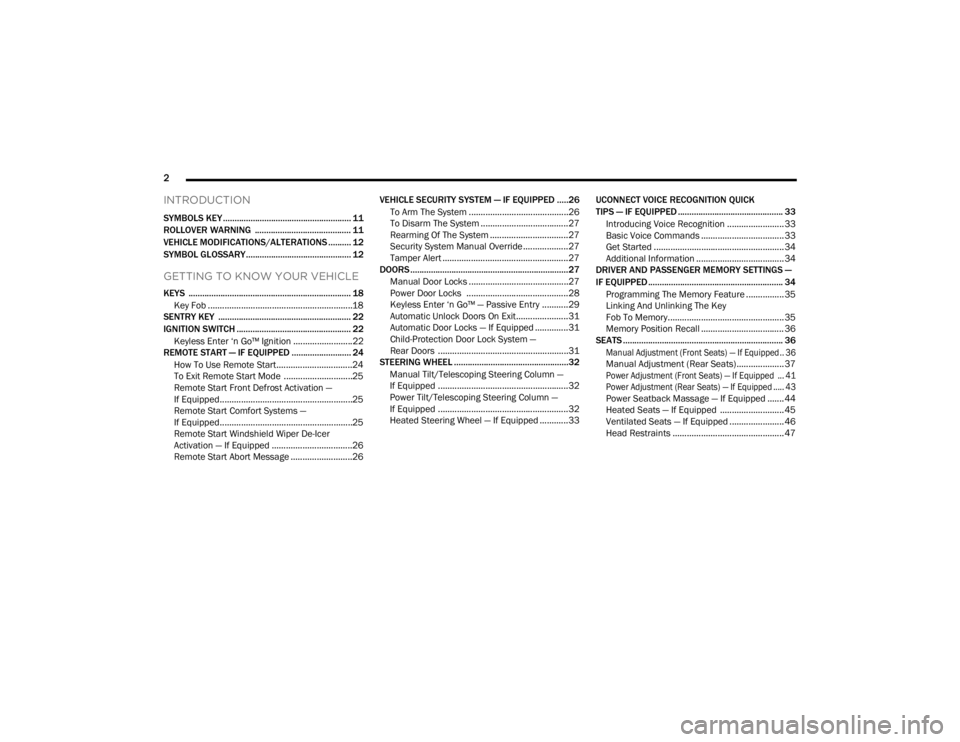
2
INTRODUCTION
SYMBOLS KEY ........................................................ 11
ROLLOVER WARNING .......................................... 11
VEHICLE MODIFICATIONS/ALTERATIONS .......... 12
SYMBOL GLOSSARY.............................................. 12
GETTING TO KNOW YOUR VEHICLE
KEYS ....................................................................... 18
Key Fob .............................................................18
SENTRY KEY .......................................................... 22
IGNITION SWITCH .................................................. 22
Keyless Enter ‘n Go™ Ignition .........................22
REMOTE START — IF EQUIPPED .......................... 24
How To Use Remote Start ................................24
To Exit Remote Start Mode .............................25
Remote Start Front Defrost Activation —
If Equipped........................................................25
Remote Start Comfort Systems —
If Equipped........................................................25
Remote Start Windshield Wiper De-Icer
Activation — If Equipped ..................................26
Remote Start Abort Message ..........................26 VEHICLE SECURITY SYSTEM — IF EQUIPPED .....26
To Arm The System ..........................................26
To Disarm The System .....................................27
Rearming Of The System .................................27
Security System Manual Override ...................27
Tamper Alert .....................................................27
DOORS .....................................................................27
Manual Door Locks ..........................................27
Power Door Locks ...........................................28
Keyless Enter ‘n Go™ — Passive Entry ...........29
Automatic Unlock Doors On Exit......................31
Automatic Door Locks — If Equipped ..............31
Child-Protection Door Lock System —
Rear Doors .......................................................31
STEERING WHEEL ..................................................32
Manual Tilt/Telescoping Steering Column —
If Equipped .......................................................32
Power Tilt/Telescoping Steering Column —
If Equipped .......................................................32
Heated Steering Wheel — If Equipped ............33 UCONNECT VOICE RECOGNITION QUICK
TIPS — IF EQUIPPED .............................................. 33
Introducing Voice Recognition ........................ 33
Basic Voice Commands ................................... 33
Get Started .......................................................34
Additional Information ..................................... 34
DRIVER AND PASSENGER MEMORY SETTINGS —
IF EQUIPPED ........................................................... 34
Programming The Memory Feature ................35
Linking And Unlinking The Key
Fob To Memory.................................................35
Memory Position Recall ................................... 36
SEATS ...................................................................... 36
Manual Adjustment (Front Seats) — If Equipped .. 36
Manual Adjustment (Rear Seats).................... 37
Power Adjustment (Front Seats) — If Equipped ... 41
Power Adjustment (Rear Seats) — If Equipped ..... 43
Power Seatback Massage — If Equipped ....... 44
Heated Seats — If Equipped ........................... 45
Ventilated Seats — If Equipped .......................46
Head Restraints ............................................... 47
23_WL_OM_EN_USC_t.book Page 2
Page 9 of 424
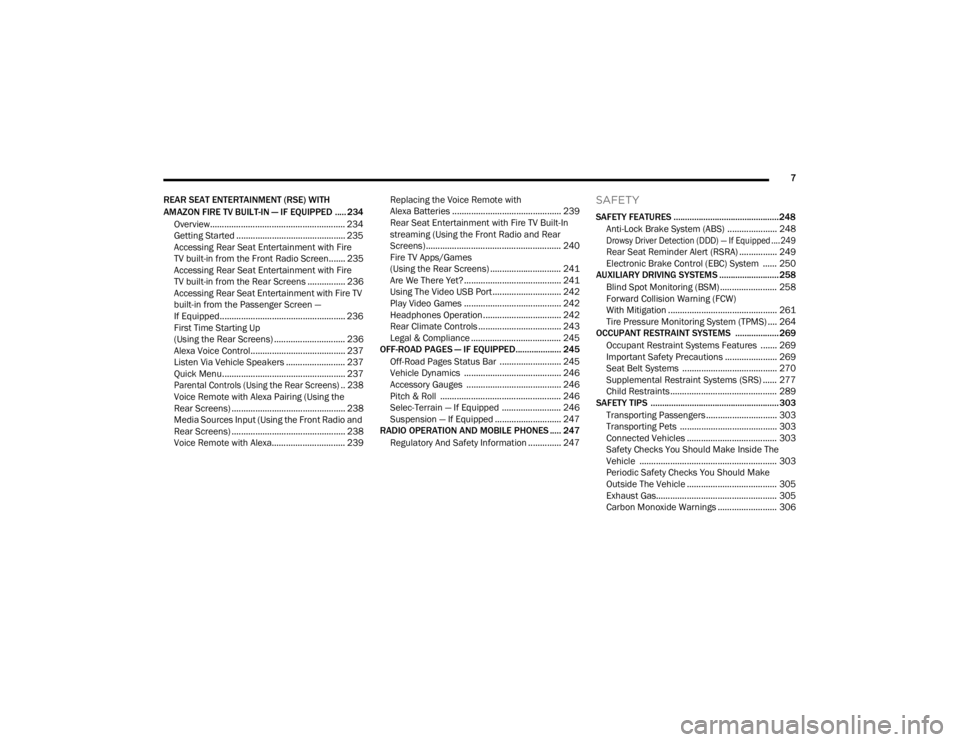
7
REAR SEAT ENTERTAINMENT (RSE) WITH
AMAZON FIRE TV BUILT-IN — IF EQUIPPED ..... 234 Overview......................................................... 234
Getting Started .............................................. 235Accessing Rear Seat Entertainment with Fire
TV built-in from the Front Radio Screen....... 235Accessing Rear Seat Entertainment with Fire
TV built-in from the Rear Screens ................ 236
Accessing Rear Seat Entertainment with Fire TV
built-in from the Passenger Screen —
If Equipped..................................................... 236
First Time Starting Up
(Using the Rear Screens) .............................. 236Alexa Voice Control........................................ 237
Listen Via Vehicle Speakers ......................... 237Quick Menu.................................................... 237
Parental Controls (Using the Rear Screens) .. 238
Voice Remote with Alexa Pairing (Using the
Rear Screens) ................................................ 238
Media Sources Input (Using the Front Radio and
Rear Screens) ................................................ 238
Voice Remote with Alexa............................... 239 Replacing the Voice Remote with
Alexa Batteries .............................................. 239
Rear Seat Entertainment with Fire TV Built-In
streaming (Using the Front Radio and Rear
Screens) ......................................................... 240
Fire TV Apps/Games
(Using the Rear Screens) .............................. 241
Are We There Yet? ......................................... 241
Using The Video USB Port ............................. 242
Play Video Games ......................................... 242
Headphones Operation................................. 242
Rear Climate Controls ................................... 243Legal & Compliance ...................................... 245
OFF-ROAD PAGES — IF EQUIPPED.................... 245
Off-Road Pages Status Bar .......................... 245
Vehicle Dynamics ......................................... 246
Accessory Gauges ........................................ 246Pitch & Roll ................................................... 246
Selec-Terrain — If Equipped ......................... 246
Suspension — If Equipped ............................ 247
RADIO OPERATION AND MOBILE PHONES ..... 247
Regulatory And Safety Information .............. 247
SAFETY
SAFETY FEATURES .............................................. 248 Anti-Lock Brake System (ABS) ..................... 248
Drowsy Driver Detection (DDD) — If Equipped .... 249
Rear Seat Reminder Alert (RSRA) ................ 249Electronic Brake Control (EBC) System ...... 250
AUXILIARY DRIVING SYSTEMS .......................... 258
Blind Spot Monitoring (BSM) ........................ 258Forward Collision Warning (FCW)
With Mitigation .............................................. 261
Tire Pressure Monitoring System (TPMS) .... 264
OCCUPANT RESTRAINT SYSTEMS ................... 269
Occupant Restraint Systems Features ....... 269
Important Safety Precautions ...................... 269
Seat Belt Systems ........................................ 270
Supplemental Restraint Systems (SRS) ...... 277Child Restraints ............................................. 289
SAFETY TIPS ........................................................ 303
Transporting Passengers.............................. 303
Transporting Pets ......................................... 303
Connected Vehicles ...................................... 303
Safety Checks You Should Make Inside The
Vehicle .......................................................... 303Periodic Safety Checks You Should Make
Outside The Vehicle ...................................... 305
Exhaust Gas................................................... 305
Carbon Monoxide Warnings ......................... 306
23_WL_OM_EN_USC_t.book Page 7
Page 25 of 424

GETTING TO KNOW YOUR VEHICLE23
START/STOP Ignition Button
The push button ignition can be placed in the
following modes:
OFF
The engine is stopped
Some electrical devices (e.g. power locks,
alarm, etc.) are still available
ON/RUN
Driving position
All electrical devices are available (e.g. climate
controls, heated seats, etc.) START
The engine will start (when foot is on the brake
pedal)
NOTE:
If the ignition position does not change with a
push of the ignition button, and the instrument
cluster displays a message such as “Key Fob
Not Detected”, the key fob may have a low or
depleted battery. In this situation, a backup
method can be used to operate the ignition
switch. Put the nose side of the key fob (side
opposite of the emergency key) against the
START/STOP ignition button and push to
operate the ignition switch.
Replacement of the key fob battery is recom
-
mended.
Depleted Key Fob Battery Procedure
1 — OFF
2 — ON/RUN
WARNING!
When exiting the vehicle, always place the
ignition in the OFF position, remove the key
fob from the vehicle, and lock your vehicle.
Never leave children alone in a vehicle, or with
access to an unlocked vehicle.
Allowing children to be in a vehicle unattended
is dangerous for a number of reasons. A child
or others could be seriously or fatally injured.
Children should be warned not to touch the
parking brake, brake pedal or the gear
selector.
Do not leave the key fob in or near the vehicle,
or in a location accessible to children, and do
not leave Keyless Enter ‘n Go™ Ignition in the
ON/RUN position. A child could operate power
windows, other controls, or move the vehicle.
Do not leave children or animals inside parked
vehicles in hot weather. Interior heat buildup
may cause serious injury or death.
CAUTION!
An unlocked vehicle is an invitation for thieves.
Always remove key fob from the vehicle and lock
all doors when leaving the vehicle unattended.
2
23_WL_OM_EN_USC_t.book Page 23
Page 27 of 424

GETTING TO KNOW YOUR VEHICLE25
(Continued)
All of the following conditions must be met before
the engine will remote start:
Gear selector in PARK
Doors closed
Hood closed
Liftgate closed
Hazard switch off
Brake switch inactive (brake pedal not pressed)
Battery at an acceptable charge level
System not disabled from previous Remote
Start event
Vehicle Security Light is flashing
Ignition in OFF position
Fuel level meets minimum requirement
Vehicle Security system is not signaling an intru
-
sion
Malfunction Indicator Light is not illuminated
TO EXIT REMOTE START MODE
To drive the vehicle after starting the Remote Start
system, either push and release the unlock button
on the key fob to unlock the doors, or unlock the
vehicle using Keyless Enter ‘n Go™ — Passive Entry
via the door handles, and disarm the Vehicle
Security system (if equipped). Then, prior to the
end of the 15 minute cycle, push and release the
START/STOP ignition button.
The Remote Start system will turn the engine off if
the Remote Start button on the key fob is pushed
again, or if the engine is allowed to run for the
entire 15 minute cycle. Once the ignition is placed
in the ON/RUN position, the climate controls will
resume the previously set operations
(temperature, blower control, etc.).
NOTE:
To avoid unintentional shutdowns, the system
will disable for two seconds after receiving a
valid Remote Start request.
For vehicles equipped with the Keyless
Enter ‘n Go™ — Passive Entry feature, the message
“Remote Start Active — Push Start Button” will
display in the instrument cluster display until you
push the START/STOP ignition button.
REMOTE START FRONT DEFROST
A
CTIVATION — IF EQUIPPED
When Remote Start is active, and the outside
ambient temperature is 40°F (4.5°C) or below, the
system will automatically activate front defrost for
15 minutes or less. The timing is dependent on the
ambient temperature. Once the timer expires, the
system will automatically adjust the settings
depending on ambient conditions. See “Remote
Start Comfort Systems — If Equipped” in the next
section for detailed operation.
REMOTE START COMFORT SYSTEMS —
I
F EQUIPPED
When Remote Start is activated, the front and rear
defrost will automatically turn on in cold weather. The
heated steering wheel and driver heated seat feature
will turn on if selected in the Comfort menu screen
within Uconnect Settings
Ú
page 204. In warm
weather, the driver vented seat feature will
automatically turn on when Remote Start is activated,
if programmed in the Comfort menu screen. The
vehicle will adjust the climate control settings
depending on the outside ambient temperature.
WARNING!
Do not start or run an engine in a closed
garage or confined area. Exhaust gas contains
carbon monoxide (CO) which is odorless and
colorless. Carbon monoxide is poisonous and
can cause serious injury or death when
inhaled.
Keep key fobs away from children. Operation
of the Remote Start system, windows, door
locks or other controls could cause serious
injury or death.
WARNING!
2
23_WL_OM_EN_USC_t.book Page 25
Page 33 of 424
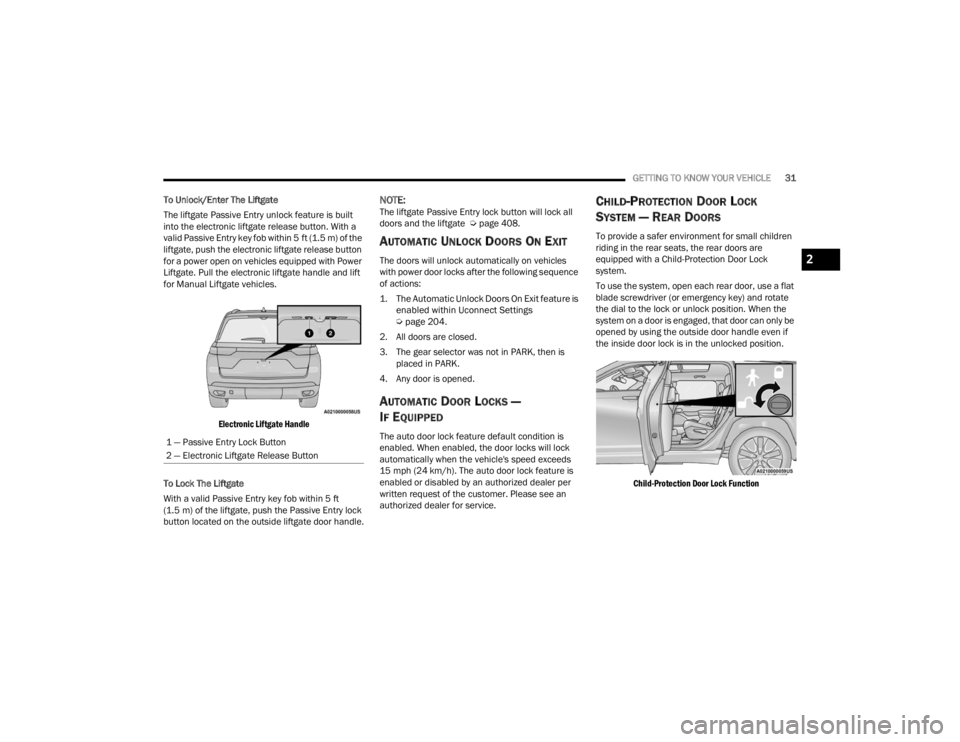
GETTING TO KNOW YOUR VEHICLE31
To Unlock/Enter The Liftgate
The liftgate Passive Entry unlock feature is built
into the electronic liftgate release button. With a
valid Passive Entry key fob within 5 ft (1.5 m) of the
liftgate, push the electronic liftgate release button
for a power open on vehicles equipped with Power
Liftgate. Pull the electronic liftgate handle and lift
for Manual Liftgate vehicles.
Electronic Liftgate Handle
To Lock The Liftgate
With a valid Passive Entry key fob within 5 ft
(1.5 m) of the liftgate, push the Passive Entry lock
button located on the outside liftgate door handle.
NOTE:The liftgate Passive Entry lock button will lock all
doors and the liftgate Ú page 408.
AUTOMATIC UNLOCK DOORS ON EXIT
The doors will unlock automatically on vehicles
with power door locks after the following sequence
of actions:
1. The Automatic Unlock Doors On Exit feature is
enabled within Uconnect Settings
Ú
page 204.
2. All doors are closed.
3. The gear selector was not in PARK, then is placed in PARK.
4. Any door is opened.
AUTOMATIC DOOR LOCKS —
I
F EQUIPPED
The auto door lock feature default condition is
enabled. When enabled, the door locks will lock
automatically when the vehicle's speed exceeds
15 mph (24 km/h). The auto door lock feature is
enabled or disabled by an authorized dealer per
written request of the customer. Please see an
authorized dealer for service.
CHILD-PROTECTION DOOR LOCK
S
YSTEM — REAR DOORS
To provide a safer environment for small children
riding in the rear seats, the rear doors are
equipped with a Child-Protection Door Lock
system.
To use the system, open each rear door, use a flat
blade screwdriver (or emergency key) and rotate
the dial to the lock or unlock position. When the
system on a door is engaged, that door can only be
opened by using the outside door handle even if
the inside door lock is in the unlocked position.
Child-Protection Door Lock Function
1 — Passive Entry Lock Button
2 — Electronic Liftgate Release Button
2
23_WL_OM_EN_USC_t.book Page 31
Page 40 of 424

38GETTING TO KNOW YOUR VEHICLE
Second Row Bench Seat — If Equipped
SECOND ROW BENCH SEAT FORWARD/REAR -
WARD ADJUSTMENT
Lift up on the adjusting bar located at the front of
the seat near the floor and release it when the seat
is at the desired position. Then, using body
pressure, move forward and rearward on the seat
to be sure that the seat adjusters have latched.
Rear Seat Adjustment Bar
SECOND ROW BENCH SEAT RECLINE ADJUSTMENT
To recline, lean forward slightly and lift the lever
located on the outboard side of the seat. Then,
push the seat rearward to the desired position and
release the lever. To return the seatback to its
normal position, lean forward and lift the lever. To
ensure the seatback is latched, use body pressure
to lean forward and rearward.
Rear Seat Recline Lever
SECOND ROW BENCH FOLD FLAT SEAT
To provide additional storage area, each rear seat
can be folded flat. This allows for extended cargo
space and still maintains some rear seating room.
NOTE:Prior to folding the rear seat, it may be necessary
to position the front seat to its mid-track position.
Also, be sure that the front seats are fully upright
and positioned forward. This will allow the rear seat
to fold down easily.To lower the seatback, pull upward on the recline
lever located on the outboard side of the seat, and
let the seatback fold forward automatically.
Second Row Bench Seat Folded Flat
To raise the seatback, fold the seatback up into its
original position and lock it into place.
WARNING!
Do not ride with the seatback reclined so that
the shoulder belt is no longer resting against
your chest. In a collision you could slide under
the seat belt, which could result in serious injury
or death.
WARNING!
Be certain that the seatback is securely locked
into position. If the seatback is not securely
locked into position the seat will not provide the
proper stability for child seats and/or
passengers. An improperly latched seat could
cause serious injury.
23_WL_OM_EN_USC_t.book Page 38
Page 42 of 424

40GETTING TO KNOW YOUR VEHICLE
SECOND ROW CAPTAIN’S CHAIRS RECLINE
ADJUSTMENT
To recline, lean forward slightly and lift the lever
located on the outboard side of the seat. Then,
push the seat rearward to the desired position and
release the lever. To return the seatback to its
normal position, lean forward and lift the lever. To
ensure the seatback is latched, use body pressure
to lean forward and rearward.
Rear Seat Recline Lever
SECOND ROW CAPTAIN’S CHAIRS FOLD FLAT
SEATS
The second row seatbacks can be folded flat to
carry cargo.
Pull upward on the recline lever located on the
outboard side of each second row seat, and guide
the seatback down into the folded position.
Second Row Captain’s Chairs Folded Flat
To Raise The Rear Seats
Fold the seatbacks upward to their original
position, and lock them into place.
SECOND ROW CAPTAIN’S CHAIR EASY ACCESS
FOR THIRD ROW
The second row seats can tip forward to allow
passengers to easily access the third row seats.
Pull upward on the easy entry lever located on the
outboard side of the seatback, then tip and slide
the entire seat forward.
Easy Entry Lever Location
WARNING!
Do not ride with the seatback reclined so that
the shoulder belt is no longer resting against
your chest. In a collision you could slide under
the seat belt, which could result in serious injury
or death.
WARNING!
Be certain that the seatback is securely locked
into position. If the seatback is not securely
locked into position the seat will not provide the
proper stability for child seats and/or
passengers. An improperly latched seat could
cause serious injury.
23_WL_OM_EN_USC_t.book Page 40
Page 43 of 424
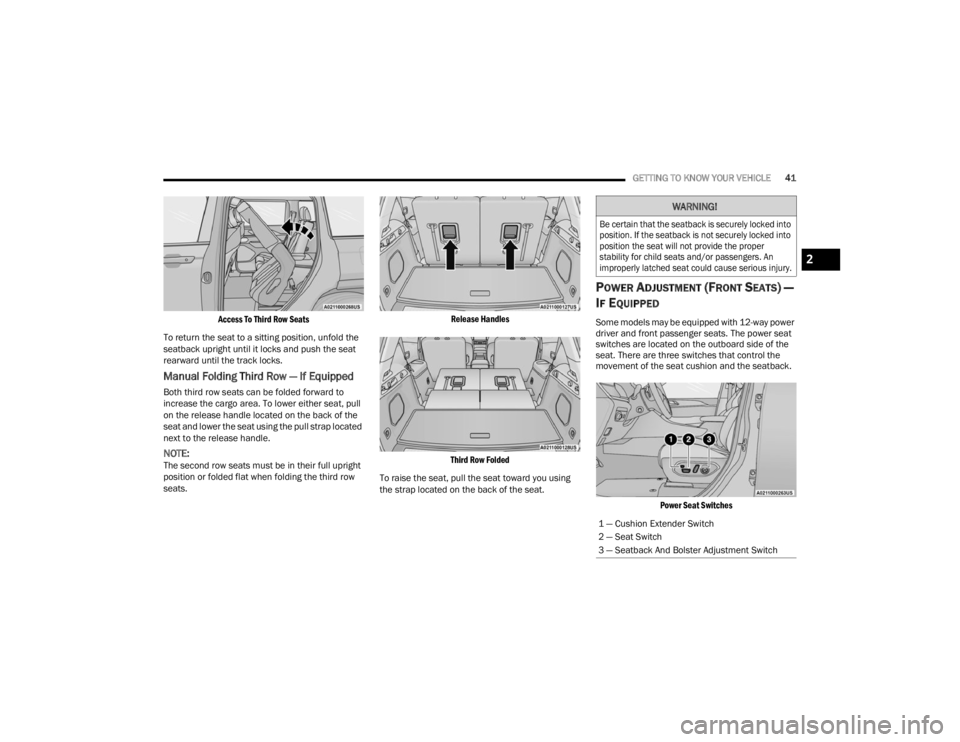
GETTING TO KNOW YOUR VEHICLE41
Access To Third Row Seats
To return the seat to a sitting position, unfold the
seatback upright until it locks and push the seat
rearward until the track locks.
Manual Folding Third Row — If Equipped
Both third row seats can be folded forward to
increase the cargo area. To lower either seat, pull
on the release handle located on the back of the
seat and lower the seat using the pull strap located
next to the release handle.
NOTE:The second row seats must be in their full upright
position or folded flat when folding the third row
seats.
Release Handles
Third Row Folded
To raise the seat, pull the seat toward you using
the strap located on the back of the seat.
POWER ADJUSTMENT (FRONT SEATS) —
I
F EQUIPPED
Some models may be equipped with 12-way power
driver and front passenger seats. The power seat
switches are located on the outboard side of the
seat. There are three switches that control the
movement of the seat cushion and the seatback.
Power Seat Switches
WARNING!
Be certain that the seatback is securely locked into
position. If the seatback is not securely locked into
position the seat will not provide the proper
stability for child seats and/or passengers. An
improperly latched seat could cause serious injury.
1 — Cushion Extender Switch
2 — Seat Switch
3 — Seatback And Bolster Adjustment Switch
2
23_WL_OM_EN_USC_t.book Page 41
Page 50 of 424

48GETTING TO KNOW YOUR VEHICLE
Head Restraints — Second Row Captain’s
Chairs (If Equipped)
If the second row is equipped with captain’s chairs,
the head restraints are not adjustable or
removable. They automatically fold forward when
the seatback is folded, and do not return to their
normal position when the seatback is raised. After
returning the seatback to its upright position after
a folding operation, raise the head restraint until it
locks in place.
Head Restraints — Second Row Bench
(If Equipped)
If the second row is equipped with a bench seat,
the head restraints on the outboard seats are not
adjustable or removable. They automatically fold
forward when the seatback is folded, and do not
return to their normal position when the seatback
is raised. After returning the seatback to its upright
position after a folding operation, raise the head
restraint until it locks in place. The center head restraint has one adjustment
position, and can be adjusted up or down when the
seat is occupied. Pull up on the head restraint to
raise it. To lower the head restraint, push the
adjustment button located on the base of the head
restraint, and push downward on the head
restraint until it locks into place.
NOTE:The center head restraint is not removable.
Center Seat Head Restraint Adjustment Button
NOTE:For information on child restraint tethering, see
Úpage 269.
WARNING!
All occupants, including the driver, should not
operate a vehicle or sit in a vehicle’s seat until
the head restraints are placed in their proper
positions in order to minimize the risk of neck
injury in the event of a crash.
Head restraints should never be adjusted
while the vehicle is in motion. Driving a vehicle
with the head restraints improperly adjusted
or removed could cause serious injury or
death in the event of a collision.
WARNING!
All occupants, including the driver, should not
operate a vehicle or sit in a vehicle’s seat until
the head restraints are placed in their proper
positions in order to minimize the risk of neck
injury in the event of a crash.
Head restraints should never be adjusted
while the vehicle is in motion. Driving a vehicle
with the head restraints improperly adjusted
or removed could cause serious injury or
death in the event of a collision.
23_WL_OM_EN_USC_t.book Page 48
Page 85 of 424
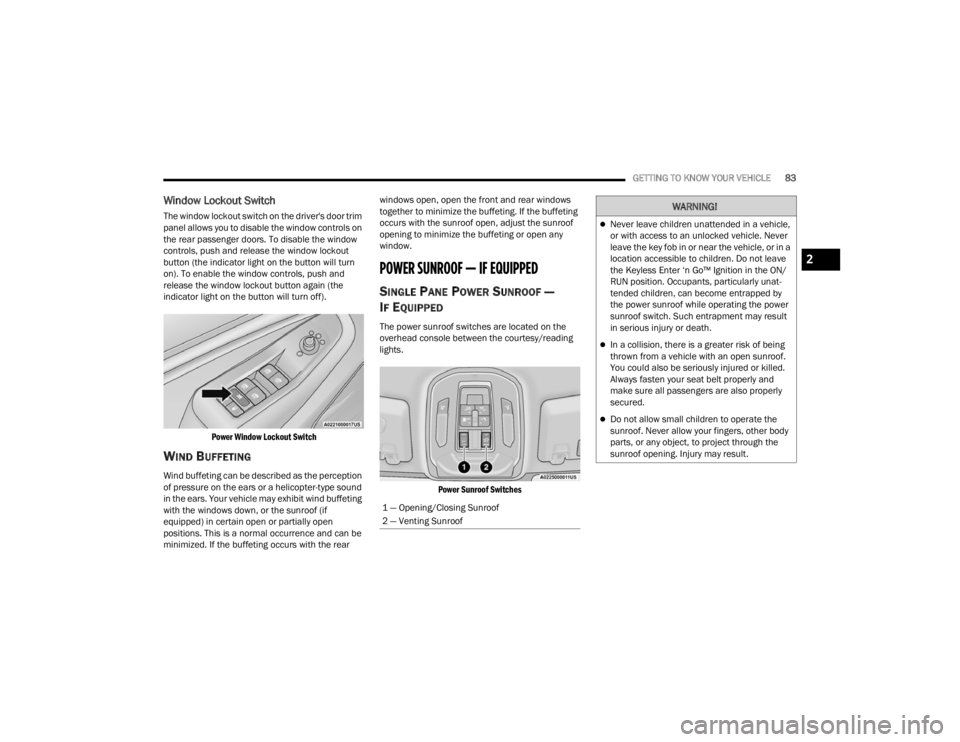
GETTING TO KNOW YOUR VEHICLE83
Window Lockout Switch
The window lockout switch on the driver's door trim
panel allows you to disable the window controls on
the rear passenger doors. To disable the window
controls, push and release the window lockout
button (the indicator light on the button will turn
on). To enable the window controls, push and
release the window lockout button again (the
indicator light on the button will turn off).
Power Window Lockout Switch
WIND BUFFETING
Wind buffeting can be described as the perception
of pressure on the ears or a helicopter-type sound
in the ears. Your vehicle may exhibit wind buffeting
with the windows down, or the sunroof (if
equipped) in certain open or partially open
positions. This is a normal occurrence and can be
minimized. If the buffeting occurs with the rear windows open, open the front and rear windows
together to minimize the buffeting. If the buffeting
occurs with the sunroof open, adjust the sunroof
opening to minimize the buffeting or open any
window.
POWER SUNROOF — IF EQUIPPED
SINGLE PANE POWER SUNROOF —
I
F EQUIPPED
The power sunroof switches are located on the
overhead console between the courtesy/reading
lights.
Power Sunroof Switches
1 — Opening/Closing Sunroof
2 — Venting Sunroof
WARNING!
Never leave children unattended in a vehicle,
or with access to an unlocked vehicle. Never
leave the key fob in or near the vehicle, or in a
location accessible to children. Do not leave
the Keyless Enter ‘n Go™ Ignition in the ON/
RUN position. Occupants, particularly unat -
tended children, can become entrapped by
the power sunroof while operating the power
sunroof switch. Such entrapment may result
in serious injury or death.
In a collision, there is a greater risk of being
thrown from a vehicle with an open sunroof.
You could also be seriously injured or killed.
Always fasten your seat belt properly and
make sure all passengers are also properly
secured.
Do not allow small children to operate the
sunroof. Never allow your fingers, other body
parts, or any object, to project through the
sunroof opening. Injury may result.
2
23_WL_OM_EN_USC_t.book Page 83